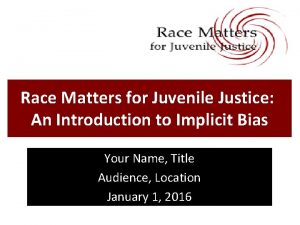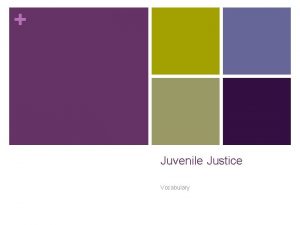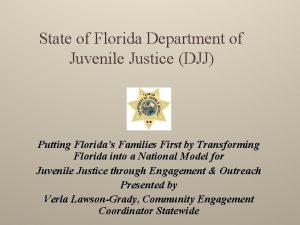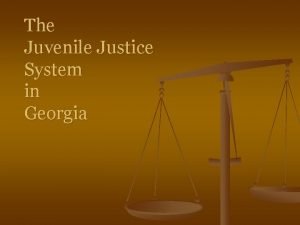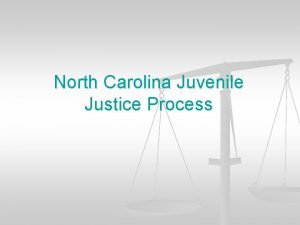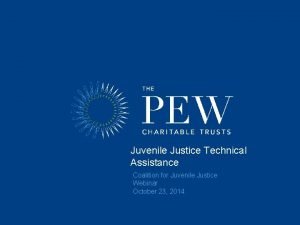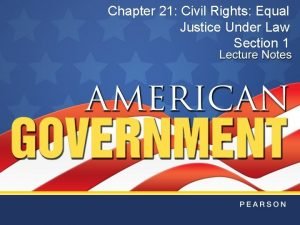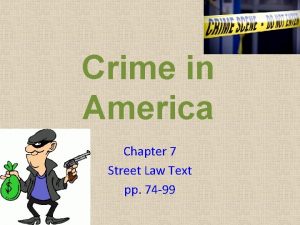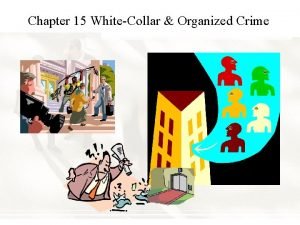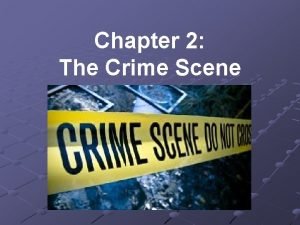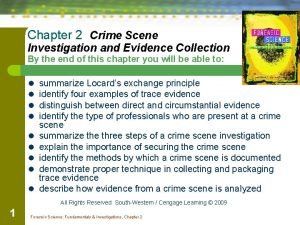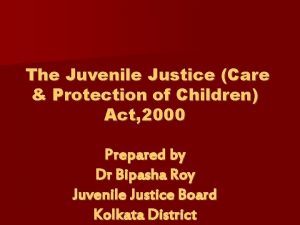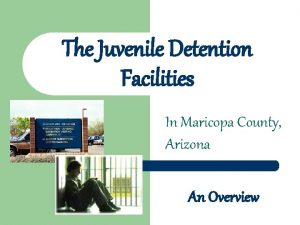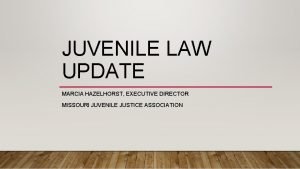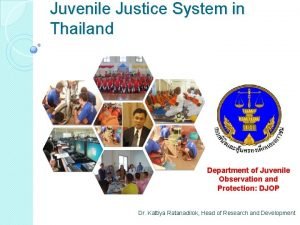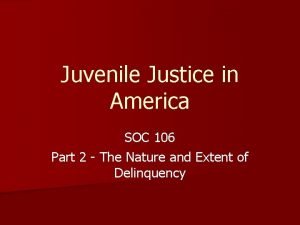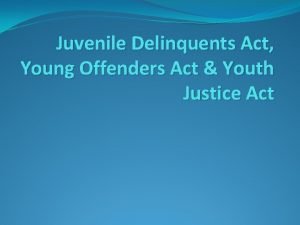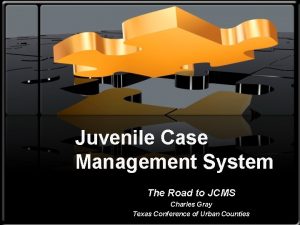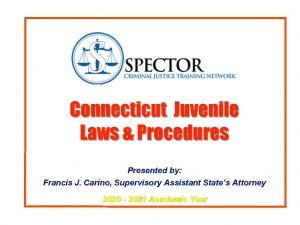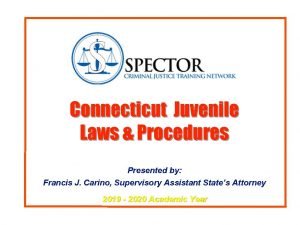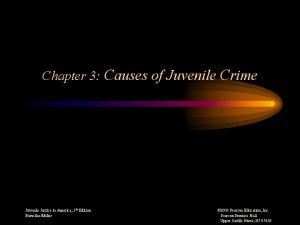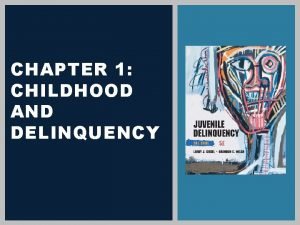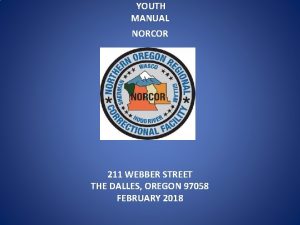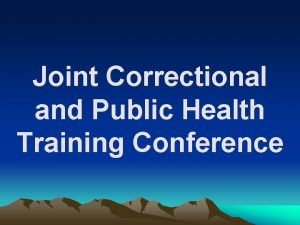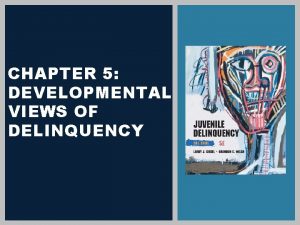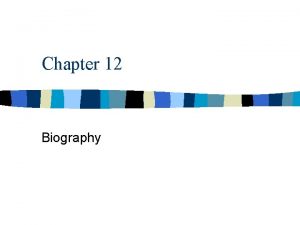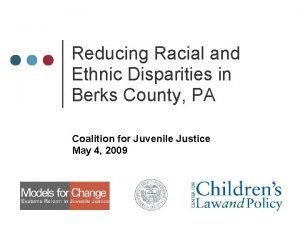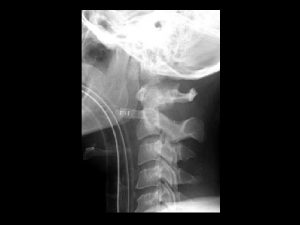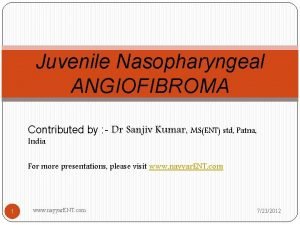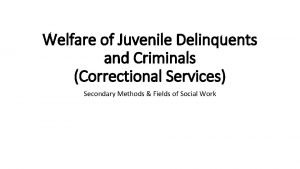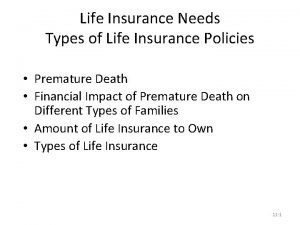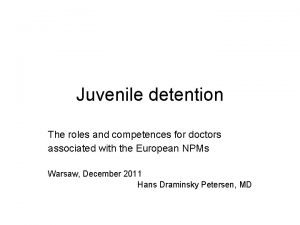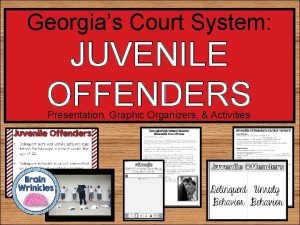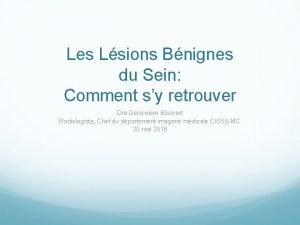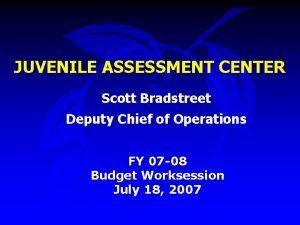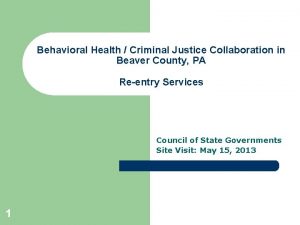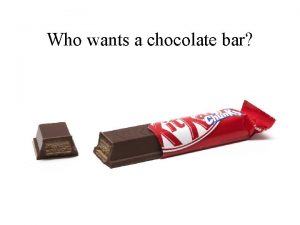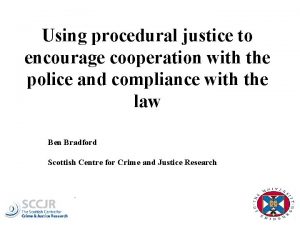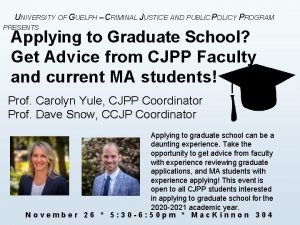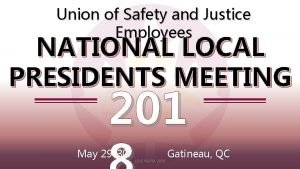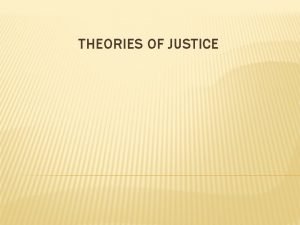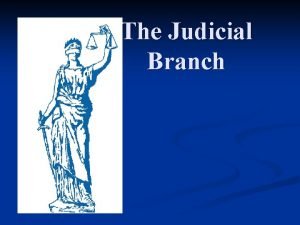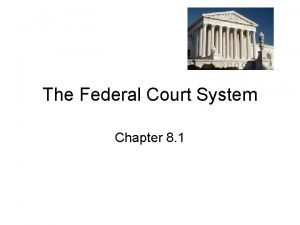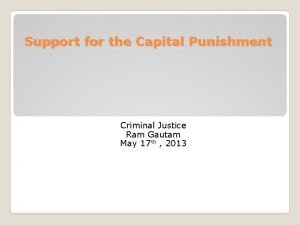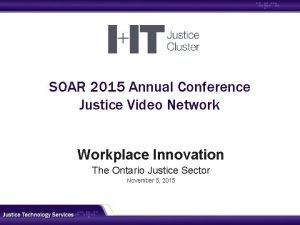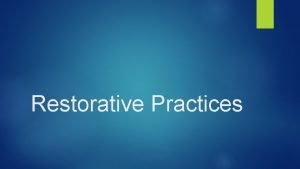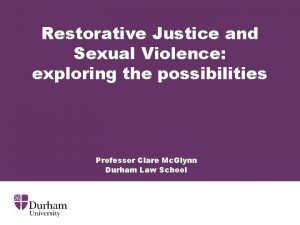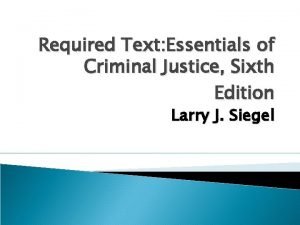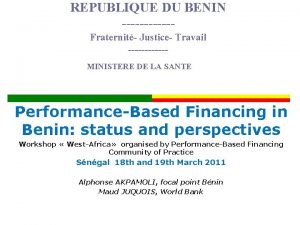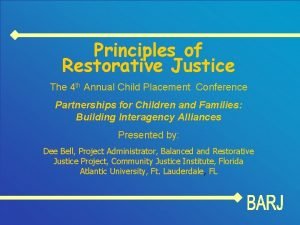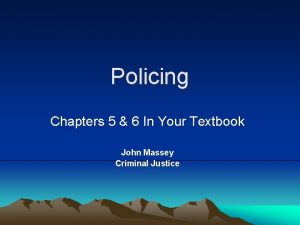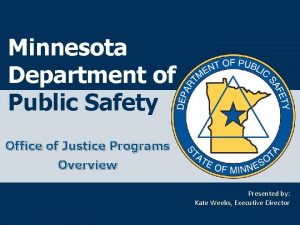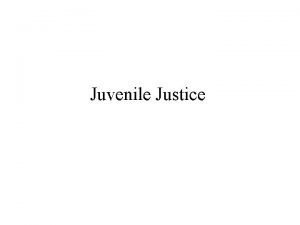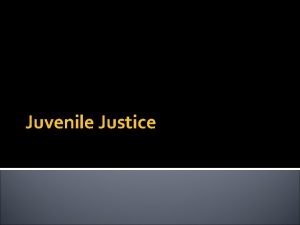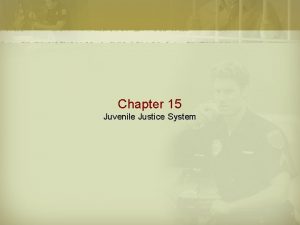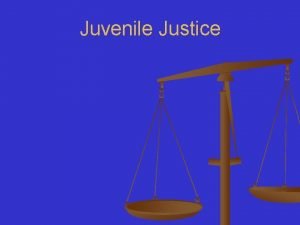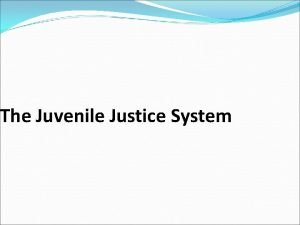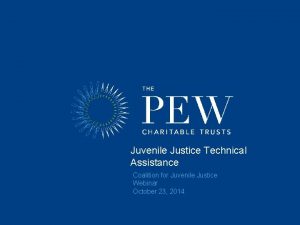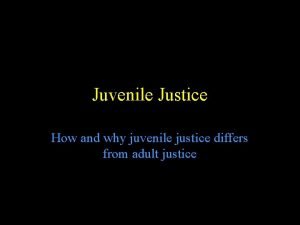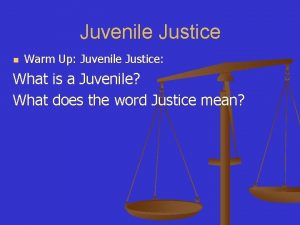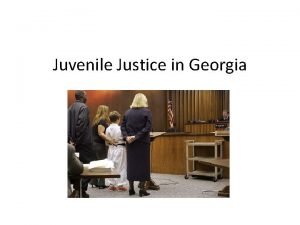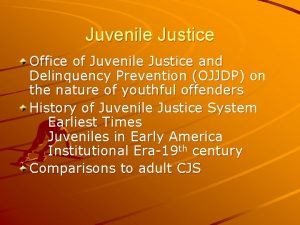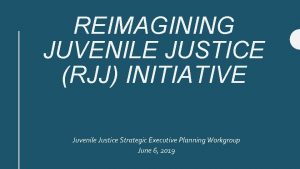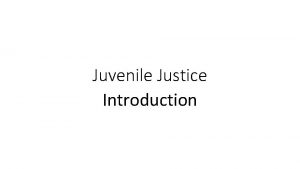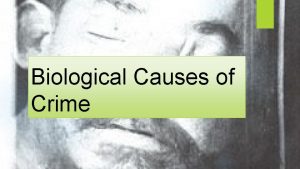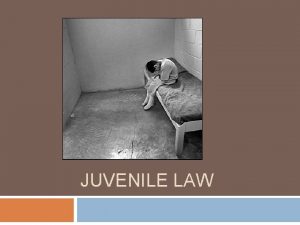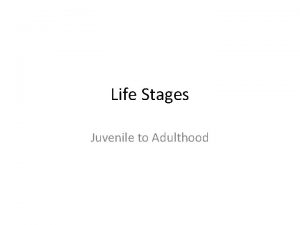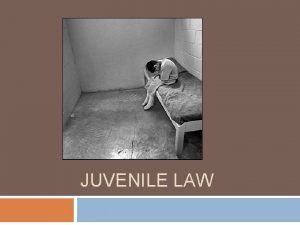Chapter 3 Causes of Juvenile Crime Juvenile Justice


















































































- Slides: 82

Chapter 3: Causes of Juvenile Crime Juvenile Justice in America, 5 th Edition © 2008 Pearson Education, Inc. Bartollas/Miller Pearson Prentice Hall Upper Saddle River, NJ 07458

Outline • What Is the Relationship between Theory and Research? • Is Juvenile Crime Rational Behavior? – Classical School of Criminology – Rational Choice Theory • How Has Determinism Influenced the Development of the Positive School? – – Development of Positivism Biological Positivism Psychological Positivism Sociological Positivism Juvenile Justice in America, 5 th Edition © 2008 Pearson Education, Inc. Bartollas/Miller Pearson Prentice Hall Upper Saddle River, NJ 07458

Outline (cont. ) • How Does Integrated Theory Explain Juvenile Crime? – Gottredson and Hirschi’s General Theory of Crime – Elliot and Colleagues’ Integrated Social Process Theory – Thornberry’s Interactional Theory • Why Has Delinquency Across the Life Course Become So Important in Studying the Theories of Crime? • Application of Theory to Practice Juvenile Justice in America, 5 th Edition © 2008 Pearson Education, Inc. Bartollas/Miller Pearson Prentice Hall Upper Saddle River, NJ 07458

Objectives 1. To understand the role of free will in the classical school’s understanding of delinquent behavior 2. To be able to discuss the main forms of positivism 3. To examine how each form of positivism explains juvenile law-breaking 4. To be able to determine what types of juvenile offenders are more responsible for their actions 5. To understand how rational choice theory differs from positivism Juvenile Justice in America, 5 th Edition © 2008 Pearson Education, Inc. Bartollas/Miller Pearson Prentice Hall Upper Saddle River, NJ 07458

1. What are four explanations as to why juveniles commit crime? Describe the assumptions of each. Juvenile Justice in America, 5 th Edition © 2008 Pearson Education, Inc. Bartollas/Miller Pearson Prentice Hall Upper Saddle River, NJ 07458

Hint (p. 64): Ø Free will: First, some hold that juveniles commit unlawful behavior because they have free will and rationally choose to do so. Juvenile Justice in America, 5 th Edition © 2008 Pearson Education, Inc. Bartollas/Miller Pearson Prentice Hall Upper Saddle River, NJ 07458

Hint (pp. 64– 65): Ø Second, biological and psychological causes have long had support from those seeking explanations for youth crime. Juvenile Justice in America, 5 th Edition © 2008 Pearson Education, Inc. Bartollas/Miller Pearson Prentice Hall Upper Saddle River, NJ 07458

Hint (p. 65): Ø Third, social structural explanations argue that the youths are out of step with the norms of society because they are inadequately socialized, have been influences by antisocial peers, or are poor and have no stake in the system. Juvenile Justice in America, 5 th Edition © 2008 Pearson Education, Inc. Bartollas/Miller Pearson Prentice Hall Upper Saddle River, NJ 07458

Hint (p. 65): Ø Fourth, multi-dimensional explanations are needed to understand why juveniles violate the law. Juvenile Justice in America, 5 th Edition © 2008 Pearson Education, Inc. Bartollas/Miller Pearson Prentice Hall Upper Saddle River, NJ 07458

2. What is the difference between research and theory? Juvenile Justice in America, 5 th Edition © 2008 Pearson Education, Inc. Bartollas/Miller Pearson Prentice Hall Upper Saddle River, NJ 07458

Hint (pp. 65– 66): Ø Research finds methods to collect data, helps to identify variables to be studied, tests variables for their worth, analyzes related variables, and suggests new directions for theory. Juvenile Justice in America, 5 th Edition © 2008 Pearson Education, Inc. Bartollas/Miller Pearson Prentice Hall Upper Saddle River, NJ 07458

Hint (pp. 65– 66): Ø Theory points the ways to new research, helps derive new variables, builds interconnections among variables, interprets new and old ideas, builds systems of thought, and leads to new social and theoretical conclusions. The main task of theory is to explain the events in the world. Juvenile Justice in America, 5 th Edition © 2008 Pearson Education, Inc. Bartollas/Miller Pearson Prentice Hall Upper Saddle River, NJ 07458

3. What is free will ? Juvenile Justice in America, 5 th Edition © 2008 Pearson Education, Inc. Bartollas/Miller Pearson Prentice Hall Upper Saddle River, NJ 07458

• Based on the philosophies of Cesare Beccaria and Jeremy Bentham. • Basic theoretical concepts include: – Humans are rational creatures who have free will – Punish was justified for its practical usefulness…. its utility. Punishment was for deterrence. – Humans operate using felicific calculus…that is working to balance pleasure and pain. Juvenile Justice in America, 5 th Edition © 2008 Pearson Education, Inc. Bartollas/Miller Pearson Prentice Hall Upper Saddle River, NJ 07458

– Punishment should be sufficient to deter someone from reoffending and deter others. – Sanctions should be proclaimed in advanced and proportionate to the crime – Individuals should be judged equally and on the facts, not their beliefs. Juvenile Justice in America, 5 th Edition © 2008 Pearson Education, Inc. Bartollas/Miller Pearson Prentice Hall Upper Saddle River, NJ 07458

Ceseare Beccaria • In 1763, published the seminal essay, On Crime and Punishment. • On Crime and Punishment had a major influence on western philosophies in criminal justice and greatly impacted the development of the administration of justice in America. • Basic Tenants included: – Legitimacy of sanctions based on the social contract. – Authority for lawmaking rested with the legislator…or monarch. Responsible for ensuring the “greatest happiness for the greatest number. ” – Saw punishment as necessary and should “should be public, immediate, and necessary: the least possible in the case given; proportioned to the crime; and determined by the laws. ” – The purpose of punishment was to deter crime and not to provide societal revenge. – Effective punishment was accomplished through certainty and swiftness, not severity. Juvenile Justice in America, 5 th Edition © 2008 Pearson Education, Inc. Bartollas/Miller Pearson Prentice Hall Upper Saddle River, NJ 07458

Jeremy Bentham • Published An Introduction to the Principles of Morals and Legislation in 1780. • Believed that a rational person would do what was necessary to maximize pleasure and reduce pain. • Punishment had four objectives: – Prevent all offenses, if possible. – To persuade a person who has decided to commit an offense to commit the least serious offense possible, and – To commit as little mischief as necessary, and – To impose as small a cost on society as needed. Juvenile Justice in America, 5 th Edition © 2008 Pearson Education, Inc. Bartollas/Miller Pearson Prentice Hall Upper Saddle River, NJ 07458

Hint (pp. 68– 69): Ø Rational choice theory is an extension of the deterrence doctrine found in the classical school that includes incentives as well as deterrence and focuses on the rational calculation of payoffs and costs before delinquent and criminal acts are committed. Juvenile Justice in America, 5 th Edition © 2008 Pearson Education, Inc. Bartollas/Miller Pearson Prentice Hall Upper Saddle River, NJ 07458

• Examples of Rational Choice Theory include: – Criminal Opportunity Theory: Phillip Cook claims that “criminals tend to be somewhat selective in choosing a crime target and are most attracted to targets that appear to offer a high payoff with little effort or risk of legal consequences. • Theory emphasizes individual choice guided by the perceived costs and benefits of criminal activity. – Routine Activity Theory: Cohen and Felson linked crime increase in the 60’s and 70’s to changes in the routine activity structure of U. S. society and to a corresponding increase in target suitability and a decrease in the presence of guardians, such as neighbors, friends and families. Juvenile Justice in America, 5 th Edition © 2008 Pearson Education, Inc. Bartollas/Miller Pearson Prentice Hall Upper Saddle River, NJ 07458

4. What is the Marxist perspective? Juvenile Justice in America, 5 th Edition © 2008 Pearson Education, Inc. Bartollas/Miller Pearson Prentice Hall Upper Saddle River, NJ 07458

Hint (p. 80): Ø The Marxist perspective views the state and the law itself as ultimately tools of the economic interests of the ownership class. Juvenile Justice in America, 5 th Edition © 2008 Pearson Education, Inc. Bartollas/Miller Pearson Prentice Hall Upper Saddle River, NJ 07458

5. What is probably the most important theoretical debate in the study of crime? Juvenile Justice in America, 5 th Edition © 2008 Pearson Education, Inc. Bartollas/Miller Pearson Prentice Hall Upper Saddle River, NJ 07458

Hint (pp. 66– 68): Ø The debate is over determinism versus free will. The basic issue is whether humans freely choose or whether other factors determine their choice. Juvenile Justice in America, 5 th Edition © 2008 Pearson Education, Inc. Bartollas/Miller Pearson Prentice Hall Upper Saddle River, NJ 07458

6. According to positivism, what is human behavior? Juvenile Justice in America, 5 th Edition © 2008 Pearson Education, Inc. Bartollas/Miller Pearson Prentice Hall Upper Saddle River, NJ 07458

Hint (pp. 69– 70): Ø Human behavior is but one more facet of a universe that is part of natural order. We can scientifically study the behavior of human beings and discover how natural laws operate. Juvenile Justice in America, 5 th Edition © 2008 Pearson Education, Inc. Bartollas/Miller Pearson Prentice Hall Upper Saddle River, NJ 07458

• Positivism was the prevailing philosophical perspective at the time the juvenile court was established. • Emerged during the Progressive Era (from 1890 to 1920). • Progressive first looked at societal causes of delinquency, then biological, and lastly, psychological.

• What are three basic assumptions of positivism? Juvenile Justice in America, 5 th Edition © 2008 Pearson Education, Inc. Bartollas/Miller Pearson Prentice Hall Upper Saddle River, NJ 07458

Hints (p. 70): Ø First, the character and personal backgrounds of individuals explain delinquent behavior. Ø Second, delinquency is seen as determined by prior causes. Ø Third, the delinquent is seen as fundamentally different from the nondelinquent. Juvenile Justice in America, 5 th Edition © 2008 Pearson Education, Inc. Bartollas/Miller Pearson Prentice Hall Upper Saddle River, NJ 07458

7. Who are sociobiologists and what do they study? Juvenile Justice in America, 5 th Edition © 2008 Pearson Education, Inc. Bartollas/Miller Pearson Prentice Hall Upper Saddle River, NJ 07458

Hints (p. 71): Ø Sociobiologists link genetic and environmental factors. They investigate the relationship among antisocial behavior and biological factors and environment through studies of: • Twins and adoption: – Twins: Genetic links between twins and delinquency. Danish study found that 52% of identical twins had similar recorded acts of criminal behavior as opposed to only 22% of fraternal twins. – Adoption: Several studies have shown that children adopted from criminal parents were more likely to become criminal than those children adopted from non-criminal parents. – There are several problems with twin and adoption studies. • Chromosomal abnormalities: Men with a defective X chromosome may be more likely to engage in criminal behavior. They produce less of the enzyme MAOA, which regulates chemicals related to aggressive behavior. Juvenile Justice in America, 5 th Edition © 2008 Pearson Education, Inc. Bartollas/Miller Pearson Prentice Hall Upper Saddle River, NJ 07458

• Psychopathy : Personality of the hard-core juvenile offender. Research has found that adult sociopaths were antisocial as children. • Electrodermal activity: Criminals have a lower rate of skin conductance response (SCR), the time it takes the skin to conduct electrical current. It is argued that this affects the ability of criminals to benefit from negative reinforcement. Since fear is the most powerful reinforcer known to psychology, criminals experience no fear or anxiety. • Minimal functioning • Intelligence: Some research has tried to link intelligence and crime but the research is fraught with controversies. • Physique: William Sheldon related body types to criminality. Endomorphs, Ectomorphs, and Mesomorphs. • Chemical imbalances in the body: Low serotonin levels may be related to aggressive behavior. Cocaine causes increases in dopamine which causes a high. Juvenile Justice in America, 5 th Edition © 2008 Pearson Education, Inc. Bartollas/Miller Pearson Prentice Hall Upper Saddle River, NJ 07458

• Describe and explain the main areas of sociobiology. Juvenile Justice in America, 5 th Edition © 2008 Pearson Education, Inc. Bartollas/Miller Pearson Prentice Hall Upper Saddle River, NJ 07458

• Neuropsychology: deficit disorders and hyperactivity. • Relationship between temperament and negative behavior: Problem children tend to display deficit disorders and hyperactivity early in life and have learning problems. Juvenile Justice in America, 5 th Edition © 2008 Pearson Education, Inc. Bartollas/Miller Pearson Prentice Hall Upper Saddle River, NJ 07458

8. What are the behaviors that identify a child’s temperament? Juvenile Justice in America, 5 th Edition © 2008 Pearson Education, Inc. Bartollas/Miller Pearson Prentice Hall Upper Saddle River, NJ 07458

Hint (p. 71): Ø Activity and emotionality Ø Children who display an inordinate amount of movement compared to their peers are labeled hyperactive. Ø Emotionality ranges from very little reaction to intense emotional reactions that are out of control. Juvenile Justice in America, 5 th Edition © 2008 Pearson Education, Inc. Bartollas/Miller Pearson Prentice Hall Upper Saddle River, NJ 07458

• What are three behaviors of a hyperactive child? Juvenile Justice in America, 5 th Edition © 2008 Pearson Education, Inc. Bartollas/Miller Pearson Prentice Hall Upper Saddle River, NJ 07458

• The three behaviors are impulsivity, in- attention, and excessive motor activity. Juvenile Justice in America, 5 th Edition © 2008 Pearson Education, Inc. Bartollas/Miller Pearson Prentice Hall Upper Saddle River, NJ 07458

9. Explain concepts in Freud’s theory of the personality. Juvenile Justice in America, 5 th Edition © 2008 Pearson Education, Inc. Bartollas/Miller Pearson Prentice Hall Upper Saddle River, NJ 07458

Hint (pp. 72– 73): Ø The id, the ego, and the superego Ø Id: related to a person’s raw instincts. Ø Ego: regulates the id and mediates between the id and superego. Ø Superego: a person’s conscience and internalizes the rules of society. Helps a child distinguish between socially acceptable behavior from socially unacceptable behavior. Juvenile Justice in America, 5 th Edition © 2008 Pearson Education, Inc. Bartollas/Miller Pearson Prentice Hall Upper Saddle River, NJ 07458

• What are the life stages that Freud has identified as shaping personality development? Juvenile Justice in America, 5 th Edition © 2008 Pearson Education, Inc. Bartollas/Miller Pearson Prentice Hall Upper Saddle River, NJ 07458

• Oral, and phallic stages – Each stage brings increased social demands on the child and affects the way in which he or she deals with basic tensions that a child must learn to resolve in a socially acceptable way. Juvenile Justice in America, 5 th Edition © 2008 Pearson Education, Inc. Bartollas/Miller Pearson Prentice Hall Upper Saddle River, NJ 07458

• Describe the oral, and phallic stages. Juvenile Justice in America, 5 th Edition © 2008 Pearson Education, Inc. Bartollas/Miller Pearson Prentice Hall Upper Saddle River, NJ 07458

• In the oral stage, pleasure is realized through eating, sucking, and chewing. • In the anal stage, bowel movements replace sucking as the basic source of pleasure for the child. • In the phallic stage, the child receives pleasure from the genitals. Juvenile Justice in America, 5 th Edition © 2008 Pearson Education, Inc. Bartollas/Miller Pearson Prentice Hall Upper Saddle River, NJ 07458

• Freud contended that by age five, all the essential ingredients of a child’s adult personality are determined. Emotional traumas experienced early in life will likely cause lifelong problems. Juvenile Justice in America, 5 th Edition © 2008 Pearson Education, Inc. Bartollas/Miller Pearson Prentice Hall Upper Saddle River, NJ 07458

• How does Freudian psychoanalysis explain delinquent behavior? Juvenile Justice in America, 5 th Edition © 2008 Pearson Education, Inc. Bartollas/Miller Pearson Prentice Hall Upper Saddle River, NJ 07458

• Freud established a relationship between desire and behavior––that a youth may feel guilty about a socially unacceptable desire, and, as a result, seek out situations in which to be punished, and then follow up the punishments with inappropriate and self-defeating behaviors. • Second, Freud attributes delinquent behavior to a defective superego, i. e. , an inability to feel guilt, to learn from experience, or to feel affection toward others. • Third, an overly developed superego represses all negative emotional feelings in children to the degree that these repressed feelings explode in a violent act in adolescence. • Fourth, the individual searches for compensatory gratification. Juvenile Justice in America, 5 th Edition © 2008 Pearson Education, Inc. Bartollas/Miller Pearson Prentice Hall Upper Saddle River, NJ 07458

10. Explain the sensation seeking and delinquency approaches to delinquency. Juvenile Justice in America, 5 th Edition © 2008 Pearson Education, Inc. Bartollas/Miller Pearson Prentice Hall Upper Saddle River, NJ 07458

Hint (pp. 73– 74): Ø Can be defined as an individual’s need for varied, novel, and complex sensations and experiences and the willingness to take physical and social risks for the sake of such experiences. – Research has shown that male and female delinquents have higher rates of sensation seeking and lower rates of inhibited behavior than non-delinquents. Juvenile Justice in America, 5 th Edition © 2008 Pearson Education, Inc. Bartollas/Miller Pearson Prentice Hall Upper Saddle River, NJ 07458

11. What is a psychopath? Juvenile Justice in America, 5 th Edition © 2008 Pearson Education, Inc. Bartollas/Miller Pearson Prentice Hall Upper Saddle River, NJ 07458

Hints (p. 74): Ø A psychopath is acknowledged as the personality of the hard-core juvenile offender. Ø Someone with a self-obsessed personality who is disconnected from others and finds herself in conflict with the social world. Ø The extreme version is an asocial, aggressive, highly impulsive person, who feels little or no guilt and is unable to form lasting bonds of affection with other human beings. Juvenile Justice in America, 5 th Edition © 2008 Pearson Education, Inc. Bartollas/Miller Pearson Prentice Hall Upper Saddle River, NJ 07458

• Also known as the sociopath, antisocial personality, person with a conduct disorder, as well as by other names Juvenile Justice in America, 5 th Edition © 2008 Pearson Education, Inc. Bartollas/Miller Pearson Prentice Hall Upper Saddle River, NJ 07458

12. What is reinforcement theory? Juvenile Justice in America, 5 th Edition © 2008 Pearson Education, Inc. Bartollas/Miller Pearson Prentice Hall Upper Saddle River, NJ 07458

Hints (pp. 74– 75): Ø It argues that behavior is governed by its consequent rewards and punishments, as reflected in the history of the individual. Ø Most reinforcement theories are unable to relate specific societal structures to what juveniles learn. Juvenile Justice in America, 5 th Edition © 2008 Pearson Education, Inc. Bartollas/Miller Pearson Prentice Hall Upper Saddle River, NJ 07458

13. What is sociological positivism? Juvenile Justice in America, 5 th Edition © 2008 Pearson Education, Inc. Bartollas/Miller Pearson Prentice Hall Upper Saddle River, NJ 07458

Hint (p. 76): Ø Sociological positivism is the application of scientific principles to the study of human society. – Adds that the overall crime picture reflects conditions requiring collective social solutions and that social reform, rather than individual counseling, must be given the highest priority in efforts to reduce crime problems. Juvenile Justice in America, 5 th Edition © 2008 Pearson Education, Inc. Bartollas/Miller Pearson Prentice Hall Upper Saddle River, NJ 07458

14. What are the different types of sociological positivism? Briefly explain each. Juvenile Justice in America, 5 th Edition © 2008 Pearson Education, Inc. Bartollas/Miller Pearson Prentice Hall Upper Saddle River, NJ 07458

Hints (pp. 76 -77): Ø Social structural theories • Social disorganization theory • Cultural deviance theory • Strain or anomie theory Explain each. Juvenile Justice in America, 5 th Edition © 2008 Pearson Education, Inc. Bartollas/Miller Pearson Prentice Hall Upper Saddle River, NJ 07458

• Social disorganization theory views crime as resulting from the breakdown of social control by the traditional primary groups, such as the family and the neighborhood. – Shaw and Mc. Kay found that high-delinquency area were found around disorganized communities characterized by physically deteriorated and condemned buildings, economic dependence, population mobility, heterogeneous populations, high rates of school truancy, infant mortality, and tuberculosis. – Social disorganization around a city creates the conditions for crime to flourish independent of individuals who live there. – Lack of community integration and social control together with contradictory standards and values allows residents the freedom to choose crime. Juvenile Justice in America, 5 th Edition © 2008 Pearson Education, Inc. Bartollas/Miller Pearson Prentice Hall Upper Saddle River, NJ 07458

• Cultural deviance theory argues that lower class culture is characterized by a set of coal concerns, or values, that command widespread attention and a high degree of emotional involvement. The chief focal concerns include: – – – Trouble: Getting into and out of trouble is a constant concern. Toughness: Ideal personality in eyes of lower class males. Smartness: Ability to outsmart others…. the police, competitors. Excitement: Fate: Little control over the forces that control their lives. Autonomy: Personal independence as way to bring control to their lives. Juvenile Justice in America, 5 th Edition © 2008 Pearson Education, Inc. Bartollas/Miller Pearson Prentice Hall Upper Saddle River, NJ 07458

• Strain or anomie theory explains crime as what happens when people cannot achieve the major goals of their society. Juvenile Justice in America, 5 th Edition © 2008 Pearson Education, Inc. Bartollas/Miller Pearson Prentice Hall Upper Saddle River, NJ 07458

• Anomie: – Concept developed by French sociologist, Emile Durkheim in the late Nineteenth century. – Anomie relates to the inability of society to regulate the natural appetites of individuals. – In a condition of anomie, rates of all kinds nonconformity increase as people attempt to achieve their egotistical desires in ways incompatible with social order and incommensurate with their biological ability. Juvenile Justice in America, 5 th Edition © 2008 Pearson Education, Inc. Bartollas/Miller Pearson Prentice Hall Upper Saddle River, NJ 07458

• • Strain Theory, according to Robert Merton, strain occurs when differential access to opportunity structures produces relative deprivation. Human appetites and desires are not natural, but are shaped by cultural influences. When a system’s cultural values extols certain common symbols of success while its social structure restricts access to approved modes of acquiring those symbols, then anti-social behavior develops. Merton identified five ways that individuals adapt to selective blockage of access to opportunity: – – – Conformers: Believes in both the goals and means Innovators: Accept goals, but rejects the means. Ritualist: Reject goals, but accept the means. Retreatist: Rejects both the goals and the means. Rebels: Does not reject goals and means, but replaces them. Juvenile Justice in America, 5 th Edition © 2008 Pearson Education, Inc. Bartollas/Miller Pearson Prentice Hall Upper Saddle River, NJ 07458

• What are the social process theories? Discuss each. Juvenile Justice in America, 5 th Edition © 2008 Pearson Education, Inc. Bartollas/Miller Pearson Prentice Hall Upper Saddle River, NJ 07458

Hints (pp. 77– 80): • • Differential association theory Containment theory Social control theory Labeling theory Juvenile Justice in America, 5 th Edition © 2008 Pearson Education, Inc. Bartollas/Miller Pearson Prentice Hall Upper Saddle River, NJ 07458

• Differential Association Theory was developed by Edwin Sutherland’s perspective explained crime by learning in a social context through interaction and communication. • Differential association refers to the differential association with criminal and anti-criminal behavior patterns. Behavior is imitated in proportion and intensity to the social closeness between people. • Differential association has two primary elements: – The content of what is learned is important. – The process by which learning takes place is important, including the intimate informal groups and the collective and situational context where learning occurs. Juvenile Justice in America, 5 th Edition © 2008 Pearson Education, Inc. Bartollas/Miller Pearson Prentice Hall Upper Saddle River, NJ 07458

Sutherland outline 9 testable propositions: 1. Criminal behavior is learned 2. Criminal behavior is learned in interaction with other person in a process of communication. 3. The principle part of learning occurs in intimate groups. 4. Learning includes (a) techniques and (b) the specific direction of motives, drives, and rationalizations, and attitudes. 5. The specific direction of motives and drives is learned from definitions of legal codes as favorable and unfavorable. Juvenile Justice in America, 5 th Edition © 2008 Pearson Education, Inc. Bartollas/Miller Pearson Prentice Hall Upper Saddle River, NJ 07458

6. 7. 8. 9. A person becomes delinquent because of an excess of definitions favorable to violation of law over definitions unfavorable to violations of law. Differential associations may vary in frequency, duration, priority, and intensity. Criminal activity is learned through the same mechanisms as any other type of learning. Criminal behavior is an expression of general needs and values, but it is not explained by those general needs and values since noncriminal behavior is an expression of the same needs and values. Juvenile Justice in America, 5 th Edition © 2008 Pearson Education, Inc. Bartollas/Miller Pearson Prentice Hall Upper Saddle River, NJ 07458

• Containment theory, according to Walter Reckless, states that juveniles are motivated toward delinquency by “pushes” from the pressures and strains of the environment and “pulls” provided by peers. • Juveniles will violate the law unless protected by both internal and external controls, which Reckless referred to as inner and outer containments. – Outer containment comes from parents and school discipline. – Inner containment comes from a strongly developed sense of guilt and positive self-concept. Juvenile Justice in America, 5 th Edition © 2008 Pearson Education, Inc. Bartollas/Miller Pearson Prentice Hall Upper Saddle River, NJ 07458

• Social control theory states that people have to be integrated into their society in various ways or they will engage in delinquency. • Travis Herschi argued that all people would break the law if they did not fear the damage and consequences of getting caught. Tie or bonds (social bonds) to conventional parents, school, friends, employers, and so on make crime too much of a risk for most people. Juvenile Justice in America, 5 th Edition © 2008 Pearson Education, Inc. Bartollas/Miller Pearson Prentice Hall Upper Saddle River, NJ 07458

• Herschi described social bonds as consisting of four components. – Attachment: Caring about others – Commitment: An individuals investment in conventional beliefs – Involvement: Time and energy to participate in conventional activities. – Belief: In the moral validity of conventional norms and on a child’s respect for authority. • The fundamental assumption of control theory assumes the existence of a common value system within the society or group whose norms are being violated. Juvenile Justice in America, 5 th Edition © 2008 Pearson Education, Inc. Bartollas/Miller Pearson Prentice Hall Upper Saddle River, NJ 07458

• Labeling perspective points out that individuals who are identified as different, i. e. , delinquent, criminal, mentally ill, etc. , may be forced to play that role and not be admitted into “normal” society. Juvenile Justice in America, 5 th Edition © 2008 Pearson Education, Inc. Bartollas/Miller Pearson Prentice Hall Upper Saddle River, NJ 07458

• What is the underlying assumption of Conflict Theories? – Conflict theorist see inequality based on differences in wealth, status, ideas, religious beliefs, and so forth. These differences result in the formation of interest groups that struggle with each other for power. – Conflict theorist look to structural causes of crime in the conflict within society. – Crime is seen as the result of large forces (e. g. economic, form of government, etc) rather than individual pathologies. – Law is a social control mechanism. Juvenile Justice in America, 5 th Edition © 2008 Pearson Education, Inc. Bartollas/Miller Pearson Prentice Hall Upper Saddle River, NJ 07458

• What are the different types of conflict theory? Discuss them. Juvenile Justice in America, 5 th Edition © 2008 Pearson Education, Inc. Bartollas/Miller Pearson Prentice Hall Upper Saddle River, NJ 07458

• Marxist theory: The fundamental conflict is economic. This conflict is between capitalist, or propertied classes (the bourgeois), who own the means of production and wage earners who own the labor which to sell to make a living. • The result of this conflict is a class-divided society, with those in the lower classes (wage earners) being exploited by those in the upper classes (owners of capital). • Those who own the wealth have the ability to influence those in power. Juvenile Justice in America, 5 th Edition © 2008 Pearson Education, Inc. Bartollas/Miller Pearson Prentice Hall Upper Saddle River, NJ 07458

• • Power conflict theory: In essence, those who acquire power coerce gropus without power to conform. This creates two basic types of social groups, each contesting authority: the rulers and the ruled, the former trying to preserve power and the latter trying to redistribute it. Group and cultural conflict theory: In the conflict between groups, each seeks the support of the state to defend its rights and protect its interests. – As a result, the whole political process of law making and law breaking and law enforcement directly reflects deep-seated and fundamental conflicts between interest groups and their more general struggles for the control of the police power of the state. Those who win, dominate the policies that define crime. Juvenile Justice in America, 5 th Edition © 2008 Pearson Education, Inc. Bartollas/Miller Pearson Prentice Hall Upper Saddle River, NJ 07458

15. What is integrated theory? Juvenile Justice in America, 5 th Edition © 2008 Pearson Education, Inc. Bartollas/Miller Pearson Prentice Hall Upper Saddle River, NJ 07458

• Integrated theory attempts to combine two or more theories that have limited utility in explaining crime into one theory with more and broader usefulness. Juvenile Justice in America, 5 th Edition © 2008 Pearson Education, Inc. Bartollas/Miller Pearson Prentice Hall Upper Saddle River, NJ 07458

Hints (pp. 100– 104): Ø Discuss the works of the primary developers of integrated theory: • Gottfredson and Hirschi: • Wrote the book, A General Theory on Crime, where they moved away from the four components of social bonding and instead focused on selfcontrol or the lack of it that results from impulsive behavior. • Criminals lack self-control because they were poorly trained as a result of low parental investment in child rearing, poor monitoring, and disciplining practices. • The fundamental assumption is the same as control theory: All people are motivated to break the law and they make a rational choice to do so. Most people don’t break the law because they were socialized not to. Juvenile Justice in America, 5 th Edition © 2008 Pearson Education, Inc. Bartollas/Miller Pearson Prentice Hall Upper Saddle River, NJ 07458

• Elliott and colleagues: Uses an explanatory model that synthesizes traditional strain, social control, and social learning perspectives into a single paradigm that accounts for delinquent behavior and drug use. • Children in socially disorganized areas develop weak bonds to conventional norms. High levels of strain along with the weak bonds, leads some children to seek out delinquent peer groups. The anti-social peer groups provide positive reinforcement for delinquent behavior and role models for conduct. Juvenile Justice in America, 5 th Edition © 2008 Pearson Education, Inc. Bartollas/Miller Pearson Prentice Hall Upper Saddle River, NJ 07458

• Thornberry’s Interactional Model: • Delinquency comes from weakening of the person’s bond to conventional society. • Associations with delinquent peers and values is where delinquent behavior is learned and reinforced. • Weakening of bonds to conventional behavior and delinquent associations along with delinquent acts creates a causal loop that lead to increased delinquency over time. • Theory views delinquency as something that occurs in developmental fashion. Delinquency is not viewed as the end product; instead, it leads to the formation of delinquent values, which then contribute to disconnections in social bonds, more attachments to antisocial peers and the additional involvement in delinquent behavior. Juvenile Justice in America, 5 th Edition © 2008 Pearson Education, Inc. Bartollas/Miller Pearson Prentice Hall Upper Saddle River, NJ 07458

• What is delinquency across the life course or life-course criminology (DLC), and why is it important in studying juvenile crime? Juvenile Justice in America, 5 th Edition © 2008 Pearson Education, Inc. Bartollas/Miller Pearson Prentice Hall Upper Saddle River, NJ 07458

Hints (pp. 85– 86): Ø Sampson and Laub: Conducted an analysis of data used in an earlier study of delinquency from the 1950’s. Ø Sampson and Laub found that although adult crime is connected to childhood behavior, both incremental and abrupt changes still take place through changes in adult social bonds. Ø The emergence of strong social bonds to work and family among adults deflects early behavior trajectories. Ø Developed the concept of “turning point. ” A turning point involves a gradual or dramatic change and may lead to “a modification, reshaping, or transition from one state, condition, or phase to another. ” Juvenile Justice in America, 5 th Edition © 2008 Pearson Education, Inc. Bartollas/Miller Pearson Prentice Hall Upper Saddle River, NJ 07458
 Race matters for juvenile justice
Race matters for juvenile justice Chapter 11 basic concepts street law
Chapter 11 basic concepts street law Under 15 years old
Under 15 years old Juvenile delinquency vocabulary words
Juvenile delinquency vocabulary words State of florida department of juvenile justice
State of florida department of juvenile justice Expulsion
Expulsion Juvenile justice system georgia
Juvenile justice system georgia Juvenile justice act 2000
Juvenile justice act 2000 North carolina juvenile justice
North carolina juvenile justice Juvenile justice system in georgia
Juvenile justice system in georgia Coalition for juvenile justice
Coalition for juvenile justice Minnesota juvenile justice system
Minnesota juvenile justice system Juvenile crime singapore
Juvenile crime singapore Nursing management of juvenile delinquency
Nursing management of juvenile delinquency Proximate causation biology example
Proximate causation biology example Ultimate and proximate causes of behaviour
Ultimate and proximate causes of behaviour Chapter 21 civil rights equal justice under law
Chapter 21 civil rights equal justice under law Chapter 8 summary and then there were none
Chapter 8 summary and then there were none Chapter 7 deviance crime and social control
Chapter 7 deviance crime and social control Chapter 7 crime in america pdf
Chapter 7 crime in america pdf Born a crime chapter 15
Born a crime chapter 15 How do investigators package dangerous sharp items
How do investigators package dangerous sharp items Chapter 2 crime scene investigation and evidence collection
Chapter 2 crime scene investigation and evidence collection Chapter 12 section 1 what causes air pollution
Chapter 12 section 1 what causes air pollution Chapter 12 air section 1 what causes air pollution
Chapter 12 air section 1 what causes air pollution Cncp and ccl
Cncp and ccl Sef juvenile detention
Sef juvenile detention State of connecticut division of criminal justice
State of connecticut division of criminal justice Sjpu
Sjpu Juvenile rheumatoid arthritis symptoms
Juvenile rheumatoid arthritis symptoms Missouri juvenile officer performance standards
Missouri juvenile officer performance standards Department of juvenile observation and protection
Department of juvenile observation and protection Juvenile delinquents act 1908
Juvenile delinquents act 1908 Soc 106
Soc 106 Juvenile delinquents turn heroes
Juvenile delinquents turn heroes Young offenders act
Young offenders act Juvenile case management system
Juvenile case management system Fran carino
Fran carino Fran carino juvenile law
Fran carino juvenile law According to choice theorists, offenders
According to choice theorists, offenders Juvenile
Juvenile What is the nature and extent of juvenile delinquency
What is the nature and extent of juvenile delinquency Juvenile delinquency objectives
Juvenile delinquency objectives Norcor juvenile detention
Norcor juvenile detention Poverty and juvenile delinquency
Poverty and juvenile delinquency Largest county in florida
Largest county in florida Drk juvenile center
Drk juvenile center Developmental theory juvenile delinquency
Developmental theory juvenile delinquency Juvenile biography
Juvenile biography Berks county juvenile probation
Berks county juvenile probation Juvenile rheumatoid arthritis
Juvenile rheumatoid arthritis Angiofibroma nasofaring juvenile radiology
Angiofibroma nasofaring juvenile radiology Seminole county juvenile detention center
Seminole county juvenile detention center Classification of juvenile delinquency
Classification of juvenile delinquency Juvenile life insurance
Juvenile life insurance Management of juvenile delinquency
Management of juvenile delinquency Juvenile delinquency graphic organizer
Juvenile delinquency graphic organizer Fibroadénome juvénile
Fibroadénome juvénile Indeterminate sentencing juvenile
Indeterminate sentencing juvenile Orange county juvenile assessment center
Orange county juvenile assessment center Cjab
Cjab Distributive justice definition
Distributive justice definition Procedural justice
Procedural justice Ccjp guelph
Ccjp guelph Union of safety and justice employees
Union of safety and justice employees Theories of justice
Theories of justice Tempest themes
Tempest themes Lady justice blindfold meaning
Lady justice blindfold meaning Lady justice meaning
Lady justice meaning What are the branches of criminal justice system
What are the branches of criminal justice system Justice for jenny
Justice for jenny Retributive justice examples
Retributive justice examples Immigrant definiton
Immigrant definiton Justice video network
Justice video network Retributive justice examples
Retributive justice examples Justice diamante
Justice diamante Rehabilitative justice examples
Rehabilitative justice examples Criminal justice funnel
Criminal justice funnel Fraternite justice travail
Fraternite justice travail Principle of restorative justice
Principle of restorative justice Grass eater vs meat eater police
Grass eater vs meat eater police The native shield is the symbol of the pc
The native shield is the symbol of the pc Office of justice programs mn
Office of justice programs mn
